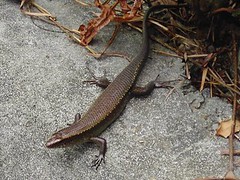Friday, February 29, 2008
Birdwatching on 29 Feb 08
Start: PGP
End: CDTL
Bird List:
1. White-vented Myna
2. Black-naped Oriole
3. 2 Collared Kingfishers (seemingly getting ready to mate)
4. A grey-vented bird with white rings roung its eyes which we could not identify.
5. A brown bird in the bush near NUH with a fan tail spotted by Edward, which was off before we could identify.
6. A bird in the woods behind KEVII Hall with a magnificent white crown and white chest, which we again failed to identify.
7. Sunbirds (one of which was a purple throated female)
8. Cockatoo
9. Swiftlets
10. Pink-necked Pigeon
11. Yellow vented Bulbul
12. Crow (heard)
13. Woodpecker (heard)
14. Koel
Note: No luck with the mammal traps today either. it probably rained over the night and the animals did not come out. One other strange thing was, the YCK baits are mysteriously disappearing though the traps did not shut.
Possible explanation 1: The ants took it.
Possible explanation 2: The rain made it soggy and it fell off the hook. Then the mammals took it without having to trigger the trap.
How would a bird feel when it was fogged out?
A previous year-long stay in Old Kent Ridge Residences, also known as Ridge View Residences has taught me something. Never leave your windows and doors open on Thursday as that is when they fog the campus.
Usually, I would brush it off. Until I started on this UROPs module that I realise the fauna in our own backyard is fogged out by us. We are murderers! Well, not really, we did not actively kill them; but some definitely died in the stead of the mosquitoes - the cause of routine fumigation.
Not only was I chased out of the forest, I did not get any mammals in the trap either.
Bird watching alone: a different perspective
Weather: Sunny
Line transect for bird watching from PGP to CDTL
List of birds spotted:
1. Swiftlets
2. White-vented Myna (seems to be mating season for them!)
3. Dollarbird
4. 2 Greater Racket-tailed Drongo
5. Brahminy Kite
6. Sunbirds
7. Cockatoo
8. Black-naped Oriole
9. Swifts
10. Asian Koel
11. 2 Blue-tailed Bee-eater on the same tree as yesterday!
12. Yellow-vented Bulbul
13. Laced Woodpecker (in Tiup tiup plot 1)
14. Black Drongo (in Tiup tiup plot 1)
A bat was also seen near House 5 although I have no idea what species it belonged to.
Some things that I took note of was that there was a certain partition as to what birds would be found in what area, even though this is a really small forest area. For example, the Yellow-vented Bulbuls are consistently found to be nearer CDTL and S2, unlikely to be found in the area behind NUH and PGP. This suggests a kind of niche even in such a small area, whereby different birds feed on different flowers or fruits of trees and hence found only where the trees are planted on.
However, this is just a preliminary observation that is based on a week's bird-watching and should not be conclusive until further experiments or studies are being carried out.
Wednesday, February 27, 2008
Mammal trap results 27th Feb 08
This was what happened to me today. The rat was weighed and as Dexiang tried to hold it in his hands for measurement, it made a fruitful leap for its life and was off! :(
The rat weighed 210g. Nothing else informative. I did not even get a photograph of it, let alone identifying it.
Tomorrow will be better, hopefully.
Common squirrels around campus
Real hungry Pink-necked pigeons
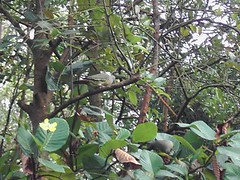
Spotted just opposite CDTL, these brood of about 5 Pink-necked pigeons finished the fruits of the simpoh air in about an hour!
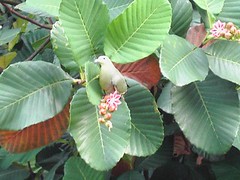
These early risers are up and about at 8am!
Bird watching list 27th Feb 08:
1. 5 Pink-necked Pigeons on simpoh air
2. White-vented Myna
3. Swiftlets
4. 2 Brahminy Kites soaring together (one should be a young)
5. Sunbirds (seen and heard)
6. Swifts (do not flap as much as swiftlets and are much larger)
7. Dollarbirds
8. Large-billed Crow (seen and heard)
9. Cream-vented Bulbul
10. Yellow-vented Bulbuls (on simpoh air and tembusu)
11. 3 Black Bazas (almost mistaken as crows until the elaborate undersides are seen)
12. 3 Cockatoos (you wouldn't believe it, chasing and seemingly attacking an immature Brahminy Kite! Stood awed by the sight and the loud cackling of the Cockatoos for a good 20 minutes!)
13. 3 Blue tailed Bee-eater
14. Koel spotted at House 4

A Yellow-vented Bulbul. The picture taken was not fantastic but this is one of the few times a bulbul stopped and let me take its photo.
Tuesday, February 26, 2008
Rain, rain,go away...
The result: no rat within the traps but only ants and ants' nest. Had to change the soggy, not-so-nice-smelling you char kway to fresh ones and set the 5 other traps which I missed out on yesterday due to the rain.
If the ants come to the dough sticks before my mammal does, I think the mammal will not be interested in the dough sticks anymore. I'm quite afraid that the mammal will be bitten by the ants if trapped in for too long.
I hope it will not continue raining, but I think Alicia will be happier if it does. Today toads are croaking non-stop everywhere. But she happens to be in Malaysia.
The difference between a second timer and an experienced bird watcher
Here's the not so short list (26th Feb 08):
1. Swiftlets
2. many White-vented Myna
3. many Yellow-vented Bulbul
4. many Sunbirds
5. Pink-necked Pigeon (once on a tree on the ridge, once outside Co-op at LT 27)
6. Brahminy Kite (caused quite a commotion every time it appears, with the sunbird leaving their roost)
7. White-throated Kingfisher (spotted by Dexiang)
8. Cuckoo (heard)
9. Cockatoo (heard)
10. Koel (heard)
11. Crow (seen and heard consistently)
12. Oriole (over NUH)
Mammal Trapping plots
Simpoh air (mixed) plot - forest plot near IMCB, across the road from S2 (5 traps)
Tiup tiup plot 1 - forest plot behind University Hall (5 traps)
Tiup tiup plot 2 - forest plot on the left of drain directly opposite Tiup tiup plot 1 (5 traps)
Tiup tiup plot 3 - forest plot on the right of drain directly opposite Tiup tiup plot 1 (4 traps)
Total number of traps: 24

Traps used are the common rat traps that snap close when an animal pushes against the bait. Size of trap: 28x18cm
Baits used: banana, papaya, you char kway.
The truth about... You Char Kway
All thanks to Benjamin Lee who advised this bait and recommended reading Richard Corlett's paper on Rodent diversity in a highly degraded tropical landscape: Hong Kong, South China.
On 21st Feb 08 evening, Audrey and I went out to put the mammal traps and I tried 3 traps: 1 at the Acacia plot near KE VII Hall, 2 at the simpoh air plot near S2. The one at the Acacia plot was fixed with banana while the 2 at the simpoh air plot was fixed with you char kway.
The next day, Audrey and Alicia shouted for me 5 meters away just to say that I had a rat one of the traps at the simpoh air plot, while the one fixed up with banana did not get anything. I am guessing the fried dough sticks are nice smelling and can be noticed from afar.
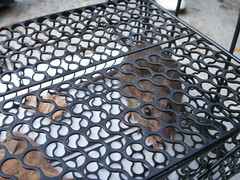
The inquisitive rat.
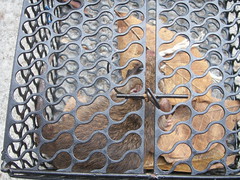
Check out the short tail (Kelvin said its probably bitten off by something).
The next thing I did was to weigh the rat, measure its length and its tail before setting it loose again. My first hand experience with a rat. An adjective for it would be - curious. It was just sniffing at our hands and was not frightened or agitated. When released, it did not even run off immediately, just hopped off slowly as Alicia made a last attempt to hold it in her hands.

Weight of the trap without rat. This rat weighed 200g.
Reference:
Kylie P.S. Chung, Richard T. Corlett, Rodent diversity in a highly degraded tropical landscape: Hong Kong, South China., Biodiversity and Conservation (2006).
Wednesday, February 20, 2008
RBZ Supplement no. 15
What a mouthful!
This book is of great help to me as it is the most recent compilation of a checklist for birds in Singapore. Out of which, a 2 hour intensive search in the museum (they have kindly lend it to me, but was not to be taken out of the museum) revealed 127 species of birds that could possibly be found in Kent Ridge or Kent Ridge Park.
The status of each bird mattered as well as "passage migrant", "winter visitor", "resident" and "introduced" gives an idea of how easily it can be found and when is the period to look for the respective birds.
Spotted by Alicia
Personally, I have also seen Egrets in school but that will be during the semester break periods where they are found near the soccer field at SRC. A coffeeshop talk with Si Gium and Mr Siva at the famous Block 40 revealed that the Egrets are probably looking for food like toads and insects on the field. If the Egrets were to be denied entry in any way, the population of anurans will increase. Alicia see, maybe this is the reason you do not find frogs and toads around easily!
I just received another message from Alicia stating that she saw another brown changeable lizard, a Calotes versicolor outside LT27 Co-op. This brings up the number of lizards to 5 which Alicia has spotted for this semester (including the one which died in her room).
Always keeping my eyes peeled.
Tuesday, February 19, 2008
Birdwatching on the ridge
Group: Goh Si Gium, Dexiang and me.
Equipments: 2 8x42 Opticron Binoculars
Route taken: A linear walk from Centre for Development in Teaching and Learning (CDTL) to Prince George's Park (PGP).
List of birds spotted:
1. Common Goldenback Woodpecker, 1 on dead tree in the background of forest facing LT32 and University Hall.
2. Sunbirds, about 4 or 5, recognised by their calls by Si Gium from the patch of the forest when we were walking through Ridge View Residences (RVR).
3. Swiftlets were seen throughout the sky from CDTL till PGP.
4. Flowerpeckers were noticed by Si Gium through their callings.
5. White crested mynahs punctuated our birdwtching session both with their callings and their appearance of quick flashes of black and white through the sky the whole morning.
6. A white throated kingfisher was recognised through its call by Si Gium, near the simpoh air bush at CDTL. who shared that there are 2 noises made by these species as compared to the rest of the kingfishers.
7. A cockatoo was heard at the point 270 water tank with its unmistakable calling. This is an escape species in Singapore. Later in the day, we heard and saw another one near the tembusu forest at PGP and suspected it being the same one.
8. Just past the stairs to S2, near the junction of Kent Ridge Road and the road leading to houses 9 and 10, 5 Black Bazas made our day by flying overhead, circling thhe sky and then making plunges near Pasir Panjang. Black Bazas are migrant, and to be able to see a flock of 5 really brightened up our day.
9. A Brahminny kite was seen circling the same area just after our excitement with the Black Bazas and was recognised by the pale underneath near the primaries. Another magnificent sight.
10. A blue-throated Beeeater was spotted by Si Gium on the dead tree behind house 10, which was just a black silhouette to me and was said that they do not fly far within a short time so we stood there, at the junction admiring the beeeater for some time.
11. Unknown to us, a quiet dollarbird was on the tree, at the junction, waiting to be spotted, and it was the dollarbird. I could not recognise it but trusted Si Gium as he is a far more experienced birdwatcher. I would have to wait till I see the undersides when it takes flight, which is going to take forever as it was just resting on the tree.
12. The singing of the sunbirds was suddenly disturbed by 2 large-billed crows in the sky, all agitated about something, which Dexiang said could be an eagle. Si Gium deduced the possibility of a crows nest on the tree in front of house 6 and something, if not a bird, was thretening the crows. The episode lasted for quite a while and the crows kept calling out to one another while circling the area.
13. As we walked on towards PGP, we saw and heard a Black-naped Oriole.
14. An Asian Brown Flycatcher, on a dead tree resting just in front of Brenner Centre for Molecular Medicine.
15. At the acacia dominated woodlands near National University Hospital (NUH), a Collared Kingfisher was spotted and did something spectacular before our very own binoculars. It left the branch it was on, swopped down at something in midair, and flew back to the branch almost immediately.
16 and 17. In the same small patch of acacia trees, 2 Striped Tit-babblers and a Tiger Shrike prettily perching in full view just a few meters away from us.
18. A Greater Racket-tailed Drongo was found in the tembusu forest patch just in front of PGP. The shy bird saw me pointing and shifted itself quickly to blend into the leaves.
19. The Common Koel was consistently heard the whole day.
Lessons learnt from this enriching day would be the firstly the technical skill. The usage of an 8x42 Opticron Binoculars as compared to Si Gium’s 10x25 is very different. An 8 times would be of lower zoom but a 42 is better in the sense that it lets more light in and hence better view in the dark and wider perimeter. However, it adds on to the bulk as well, and it would be more advisable to travel light. Another technical issue or rather, trick would be that a magnifying glass is redundant when one hold onto a binoculars. This is because, when inverted and seen through the other side, the binoculars automatically become a magnifying instrument.
Personally, I would not say I have picked up a great deal of the expertise of bird watching on my first ever trip but honestly, the excitement and interest rubbed off me. The ability to pinpoint the bird to the call from Si Gium also never fails to amaze me. The most inspiring part was that of the Collared Kingfisher in the acacia patch. Try as we could, me and Dexiang could never get its location until Si Gium’s intervention. Patience is one thing, but to be able to accurately and swiftly put a name to a silhouette or point out the exact location of a bird will really need more practice.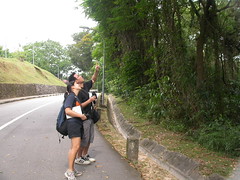
Trying to spot the Collared-Kingfisher before Si Gium does, to no avail.
Reference:
- C. Hails, F Jarvis, Birds of Singapore, 1987
- C. Briffett, A Guide to Common Birds of Singapore, 1986
- C. Briffett, Kent Ridge Environs: A proposal for conserving nature at the National University of Singapore Campus, 1991.
Lessons from: Birds of Singapore
The bird activities will be at its peak 1 hour after dawn, which is around 8am in Singapore, and it will become quieter from 11am to 4pm, after which activities resume for their last morsel before resting the night.
Breeding seasons will be from February to July for the resident species, and Singapore willbe playing host to the migrants from the month of Spetember till April.
It is stated that it would not matter that one wears bright colours for bird-watching since the birds would be able to see you from afar, having trained its eyes for the minute details of an insect or lizard. As long as it is not threaten or not very shy, it will remain in its position until it has spotted something else.
Reference:
C.Hails, F.Jarvis, Birds of Singapore, 1987.
The linkway near the AYE bus stop
Group: Matthew Lim and me
Equipment(s): a book (A Guide to Common Singapore Spiders), camera (Nikon Coolpix from Mr Siva)
List of spiders identified:
Family: Araneidae (Orb web-Spiders)
1. Cyclosa sp., juvenile, on the hedge along the linkway.
Cannot really identify the species due to its size, distinguished via the spiral pattern on web.
Likes to pretend to be one of the debris (insect carcasses) on the web
2. Araneus mitificus (Kidney Garden Spider), 3 spotted, on the hedge.
Identified by the green underparts and a black and white pattern on the upperpart of abdomen.
Likes to built a retreat on curled up leaf.
3. Gasteracantha kuhli (Black and white Spiney Spider), 2 spotted on the hedge.
Family: Salticidae (Jumping Spider)
4. Plexippus petersi (Common Housefly Catcher), 1 juvenile, 1 female and 1 male, along the linkway hidden in the pillar crevices.
Identified easily by the 2 pairs of false eyes on the abdomen.
5.Viciria praemandibularis (Wide Jaw Viciria), 1 female, 1 male on the hedge.
6.Cosmophasis sp. (not found in the book)
A genus which Matthew worked on, with some iridescent colouration on its back.
7. An ant look-alike spider found in crevice on the pillar of the linkway.
Suspected to be from the Myrmarachne spiders (Ant-mimicking Spiders).
Picture not uploaded yet.
Family: Lycosidae (Wolf Spiders)
8: Hippasa Holmerae (Lawn Wolf Spider), many on the slope adjacent to the soccer field near the linkway.
Possible follow-up: do a 1m by 1m survey.
Many thanks to Matthew Lim for firstly lending me the guidebook to start off with, and generously agreeing to come along for this enlightening trip to the neighbouring bus stop.
Matthew Lim Lek Min is currently a Research Assistant to Navjot Sodhi of the Conservation Ecology Lab, and an instructor in NUS, Faculty of Science, teaching Animal Behaviour, Ecology & Environmental Processes and Behavioural Biology.
Reference:
Joseph K H Koh, A Guide to Common Singapore Spiders,1989.
Friday, February 15, 2008
Spiders anyone?
The bad: I left the camera's battery at home today; had to take the freaking expensive cab to school to meet Matthew Lim, a researcher working on 'visual' ecology.
The good: I learn that I need not be afraid of spiders, as they are quite harmless.
With beautiful front eyes, jumping spiders are more readily recognizable to me now that I took crash course SP(iders)1101E with Matthew today. Males are generally unnoticed due to their small sizes. This is because they moult less times as compared to the females, like a ration of 3 to 8. Juveniles males are normally very different morphologically from their adult appearance. Males and females are differentiated easily by the swollen palps or lack of, respectively.
Orb weavers spin webs, but never generalize.This is because most spiders do, just not the same as the large webs with elaborate details like the orb-weavers, for the sheer purpose of a retreat, usually with a female within the "cocoon" with eggs that require some form of parental pheromones for growth and development. Then, there are the 3D web weavers which are easily encountered on the slope adjacent to the soccer field known as the Wolf spiders, with a spiral spun web of certain depth that functions like a retreat.
Photos will be updated another time. Till then, my non-existent readers!
More publishings to read...
In addition, I've finally managed to request for Shirley Pottie's Master Thesis on the bats of Singapore for general reference.
Wish me luck, I need tons of it.
Prof Murphy's collection
Something to note would be that Department of Zoology was shifted from the Bukit Timah campus to the present one at Kent Ridge in 1981. This affected my collection of results as "campus grounds" or "campus area" would indicate the one in Bukit Timah, with the year of collection as supporting evidence, prior to 1981.

